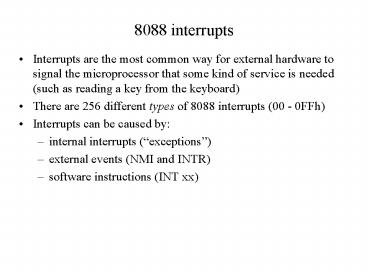8088 interrupts PowerPoint PPT Presentation
1 / 9
Title: 8088 interrupts
1
8088 interrupts
- Interrupts are the most common way for external
hardware to signal the microprocessor that some
kind of service is needed (such as reading a key
from the keyboard) - There are 256 different types of 8088 interrupts
(00 - 0FFh) - Interrupts can be caused by
- internal interrupts (exceptions)
- external events (NMI and INTR)
- software instructions (INT xx)
2
8088 interrupt sequence
- When the 8088 recognizes an interrupt, it
- 1) Completes execution of the current instruction
- 2) Pushes the flag register onto the stack
- 3) Clears the interrupt enable bit
- 4) Pushes the CS of the next instruction onto
the stack - 5) Pushes the IP of the next instruction onto
the stack - 6) Reads the interrupt type from the data bus
- 7) Does a Jump Indirect to the address stored
at - type4, type4 1 IP of interrupt service
routine type4 2, type4 3 CS of interrupt
service routine - Note this implies that the lowest 1K of memory
is reserved to hold the interrupt vector table.
3
Interrupt service routines
- An interrupt service routine is simply an
assembly language program that handles the device
requesting an interrupt. - An interrupt service routine is terminated by an
IRET instruction that - 1) pops the CS of the next instruction from the
stack - 2) pops the IP of the next instruction from the
stack - 3) pops the flag register from the stack
What function must the interrupt service routine
perform? Cause the INTR line to go low!
4
NMI
- The NMI (Non-maskable interrupt) is a
positive-edge-sensitive external input to the
8088 - The NMI cannot be ignored by the 8088
- An NMI is a type 2 interrupt.
- Its interrupt vector is stored at addresses 08,
09, 0A, and 0B. - In order to be recognized as a positive edge, the
NMI line must be low for two clock cycles - The external device must hold NMI high after
causing the edge
5
INTR
- INTR is an active-high level-sensitive interrupt
request line (external 8088 input) - Interrupt requests are recognized if the
interrupt enable bit is 1 - Interrupt requests are ignored if the interrupt
enable bit is 0 - SEI sets the interrupt enable bitCLI clears the
interrupt enable bit
6
INTA
- INTA in the 8088s interrupt acknowledge pin (an
external output) - When the 8088 recognizes an interrupt, it sends a
low pulse on INTA to signal the external device
to get ready to put the interrupt type on the
data lines - A second low pulse on INTA signals the external
device to put the type number on the data lines
7
Interrupt priorities
- An interrupt service routine can itself be
interrupted only by a higher priority interrupt - Priorities (from highest to lowest)
- Reset
- Internal interrupts and exceptions
- Software interrupts
- Non-maskable interrupt
- External hardware interrupts
- For external hardware interrupts, the higher the
type number, the lower the priority
8
Interrupt types
- Type 0 Divide Error
- Type 1 Single step
- Type 2 NMI
- Type 3 Breakpoint
- Type 4 Overflow
- Type 510 - 3110 Reserved (internal software and
BIOS) - Type 3210 - 25510 User available
9
Homework for Thursday, November 4
- Draw the connections between the 8255s and write
8088 assembly language programs to have two
computers communicate using 8255s. - Computer 1 should transmit using PortB as an
output in Mode 1. Transmit 20 bytes of data from
an array called DATAOUT (DATAOUT db
?,?,?,?,?,?,?,?) - Computer 2 should receive using PortA as an input
in Mode 1. Store the 20 bytes received in an
array called DATAIN (DATAIN db ?,?,?,?,?,?,?,?)

